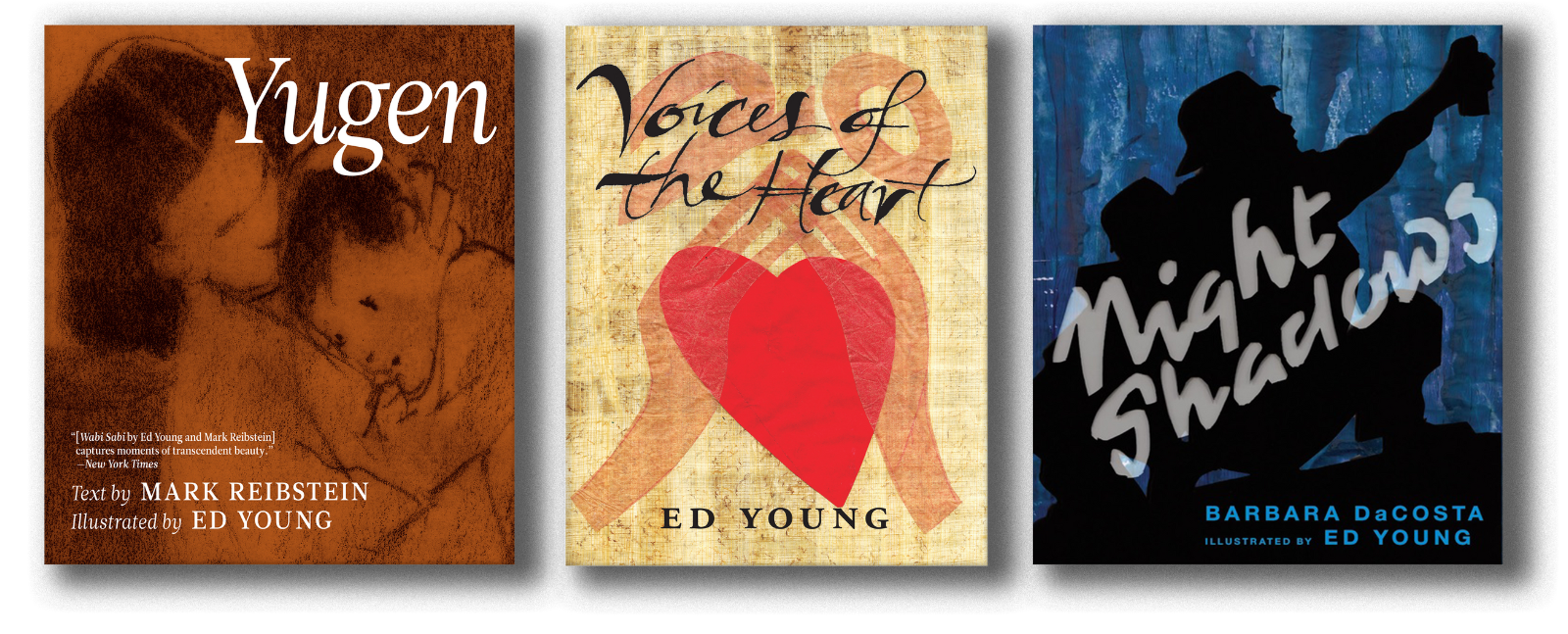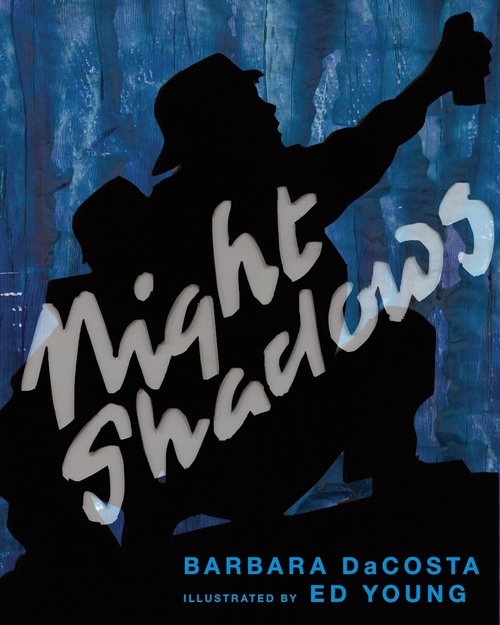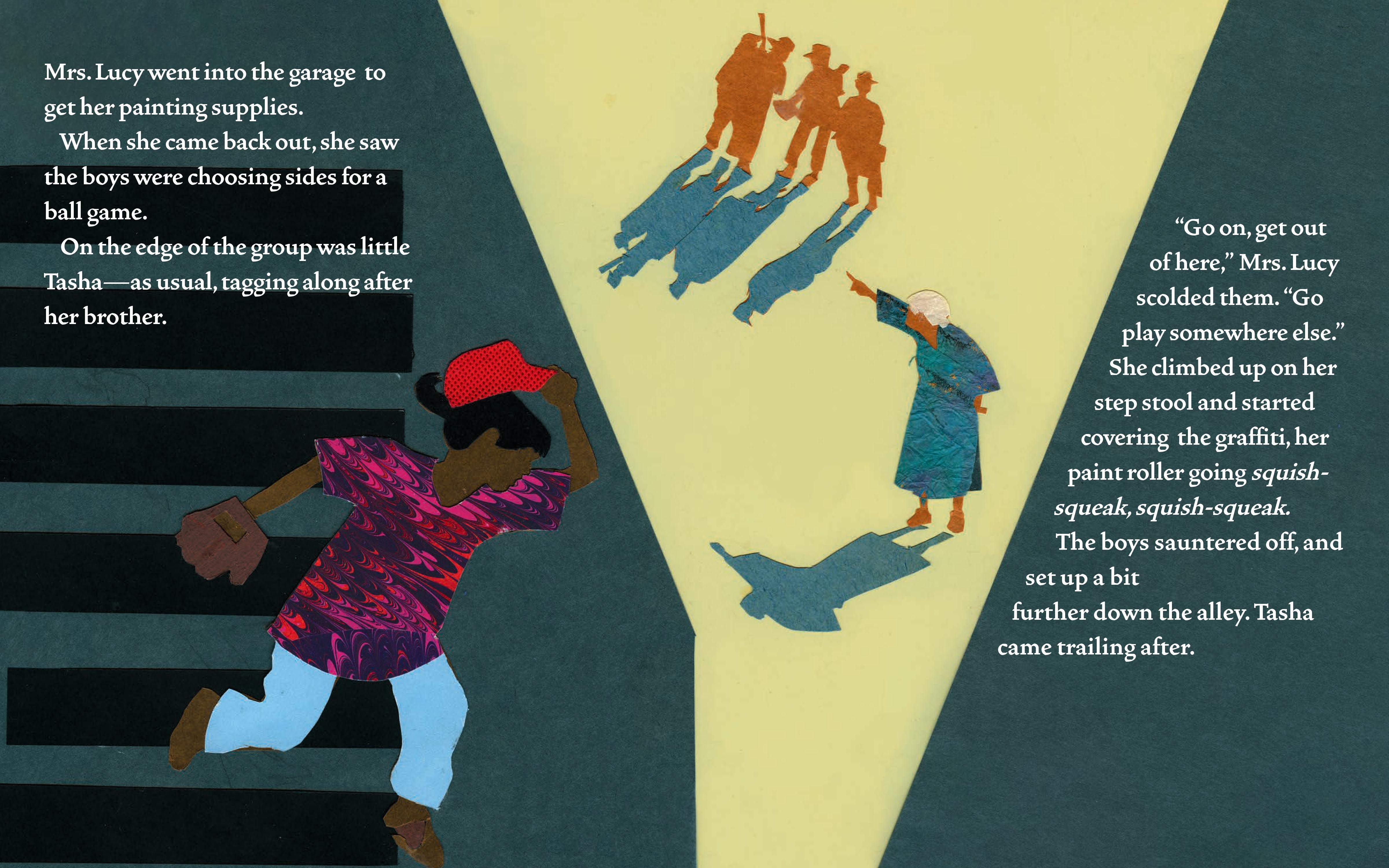Illustrated by Ed Young
The third collaboration between Young and DaCosta tells the story of a lonely girl who finds an unlikely friend in her elderly neighbor.
Each night kids have been creeping around and spray painting houses in Tasha's neighborhood. Two days in a row, her neighbor Mrs. Lucy awakes to find graffiti outside her home. Tasha helps her paint over it. They discover that they are alike, except for their age, and become inseparable. But who keeps defacing Mrs. Lucy's house? Ed Young's inimitable cut-out art sensitively conveys the characters' emotions and the drama of the story: as the truth is discovered, the houses become multicolored, but the characters remain faceless. Then when the miscreants are revealed, Tasha's and Mrs. Lucy's faces become visible. A subtle expression of recognition on both... This nuanced story shows young readers that honesty and respect are the most important elements for friendship. With Night Shadows, Caldecott Medal-winner Ed Young's oneiric illustrations and Barbara DaCosta's introspective narrative jointly reproduce the intensity with which a child experiences solitude and companionship.
Collected in
Radicalize the Kid's TableRemembering Ed Young (November 28, 1931 – September 29, 2023)
If you ever had the astonishing experience of visiting Ed Young's studio, you know the awe of seeing such an unstoppable creative force at work. Every surface had a project in the works laying across it or hanging from it. Every lamp and chair back served a second role as prop for a drawing or home to an insect crafted from cut up old credit cards or a cardboard roll refashioned into a telegraphing contraption that told a story as it extended or a tiny paper roll that unfurled with Chinese characters so beautifully drawn it could make you cry. There was no end to the imagination percolating from Ed Young’s mind and spirit into the studio in his house in Hastings-on-Hudson, New York. Perhaps most mysterious and charming was the crawlspace one was encouraged to navigate—through the garage, up a ladder, through a trapdoor, to a secret, sunny space in the next building, where many of the projects he was working on entered the last stages and then completion. What a loss to us all that the wildly creative, wonderfully human Ed Young has died at the age of 92.
 The renowned illustrator and writer of children's picture books was born on November 28, 1931, in Tientsin, China. As a young man he moved to the US, where he worked at an advertising agency before illustrating his first book, The Mean Mouse and Other Mean Stories, written by Janice May Urdry, in 1962. Since then he illustrated over eighty children's books, seventeen of which he also wrote. Throughout his long career he received over fifty awards and honors, including the Caldecott Medal in 1990 for Lon Po Po, his retelling of a Chinese version of "Little Red Riding Hood," and Caldecott Honors for The Emperor and the Kite (1967) and Seven Blind Mice (1992). He was nominated twice for the Hans Christian Andersen Award, the highest international recognition given to children's book authors and illustrators for their contribution to children's literature. His books frequently drew on folklore from Chinese, Native American, Indian, Persian, and other cultures, and he used a variety of media, including pencil, pastel, ink, collage, cut paper, photographs, and found materials.
The renowned illustrator and writer of children's picture books was born on November 28, 1931, in Tientsin, China. As a young man he moved to the US, where he worked at an advertising agency before illustrating his first book, The Mean Mouse and Other Mean Stories, written by Janice May Urdry, in 1962. Since then he illustrated over eighty children's books, seventeen of which he also wrote. Throughout his long career he received over fifty awards and honors, including the Caldecott Medal in 1990 for Lon Po Po, his retelling of a Chinese version of "Little Red Riding Hood," and Caldecott Honors for The Emperor and the Kite (1967) and Seven Blind Mice (1992). He was nominated twice for the Hans Christian Andersen Award, the highest international recognition given to children's book authors and illustrators for their contribution to children's literature. His books frequently drew on folklore from Chinese, Native American, Indian, Persian, and other cultures, and he used a variety of media, including pencil, pastel, ink, collage, cut paper, photographs, and found materials.
We had the pleasure of working with Ed on three books that he illustrated — one also written by him, one written by Barbara DaCosta, and one written by Mark Reibstein. Yugen shows, in few words and simple yet haunting black lines, the relationship of a small boy to his mother, who has gone away. Night Shadows features Ed's singular paper cutout art to tell the story of a young girl who finds companionship with her elderly neighbor. And in Voices of the Heart, Young used paint and paper art to explore twenty-six Chinese characters, each describing an emotion, and each containing somewhere the symbol for the heart.
All of his books feel deeply personal, and it's a salve to know that in them we have Ed Young with us always.
—Ruth Weiner
Publisher, Triangle Square Books for Young Readers
Director of Publicity, Seven Stories Press
October 1, 2023
Books by Ed Young

In this deeply personal book, artist and author Ed Young explores twenty-six Chinese characters, each describing a feeling or emotion, and each containing somewhere the symbol for the heart. He combines visual symbols of the West in the same manner the ancient Chinese used in composing their characters, focusing on characters that contain the heart symbol. The seal style of Chinese calligraphy that he employs is approximately 2,500 years old. Here it serves as a bridge between our contemporary selves and the most ancient Chinese pictures and symbols. Through stunning collage art that interprets the visual elements within each character, Young uncovers layers of emotional meaning for words such as joy and sorrow, respect and rudeness. He invites children to probe the full range of their own emotions, and gives parents, librarians, and older readers a context for discussing ethics and for examining the similarities and differences between old and new, East and West.
First published in 1997, the book is a truly unique exploration—or as Young writes, "adventure"—into the different moods, and dangers and abilities of the human heart—our emotional selves—to conjure and master, or fall victim to, the many challenges we face.
The third collaboration between Young and DaCosta tells the story of a lonely girl who finds an unlikely friend in her elderly neighbor.
Each night kids have been creeping around and spray painting houses in Tasha's neighborhood. Two days in a row, her neighbor Mrs. Lucy awakes to find graffiti outside her home. Tasha helps her paint over it. They discover that they are alike, except for their age, and become inseparable. But who keeps defacing Mrs. Lucy's house? Ed Young's inimitable cut-out art sensitively conveys the characters' emotions and the drama of the story: as the truth is discovered, the houses become multicolored, but the characters remain faceless. Then when the miscreants are revealed, Tasha's and Mrs. Lucy's faces become visible. A subtle expression of recognition on both... This nuanced story shows young readers that honesty and respect are the most important elements for friendship. With Night Shadows, Caldecott Medal-winner Ed Young's oneiric illustrations and Barbara DaCosta's introspective narrative jointly reproduce the intensity with which a child experiences solitude and companionship.
Yugen is the story of a boy remembering his mother, told in haiku and pictures, a book of longing and remembrance that is unequaled in its beauty and poetic simplicity. "Yugen" is not just a nickname for the main character, it is also a profound concept in Asian societies that points to the mystery and beauty of the universe and of human suffering. Yugen, the second collaboration between Caldecott-winning illustrator Ed Young and Mark Reibstein, after their award-winning 2008 debut, Wabi Sabi, beautifully captures a boy's sadness, but also his mindfulness and wonder.













